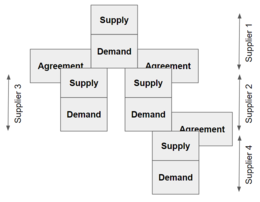
Back Vraag en aanbod AF عرض وطلب Arabic Ufierta y demanda AST Tələb və təklif AZ Ихтыяж һәм тәҡдим законы BA Закон попыту і прапановы BE Търсене и предлагане Bulgarian যোগান ও চাহিদা Bengali/Bangla Ponuda i potražnja BS Oferta i demanda Catalan
This article needs additional citations for verification. (January 2021) |
| Part of a series on |
| Economics |
|---|
| Part of a series on |
| Capitalism |
|---|


In microeconomics, supply and demand is an economic model of price determination in a market. It postulates that, holding all else equal, in a competitive market, the unit price for a particular good or other traded item such as labor or liquid financial assets, will vary until it settles at a point where the quantity demanded will equal the quantity supplied (the market-clearing price), resulting in an economic equilibrium for price and quantity transacted. The concept of supply and demand forms the theoretical basis of modern economics.
In macroeconomics, as well, the aggregate demand-aggregate supply model has been used to depict how the quantity of total output and the aggregate price level may be determined in equilibrium.